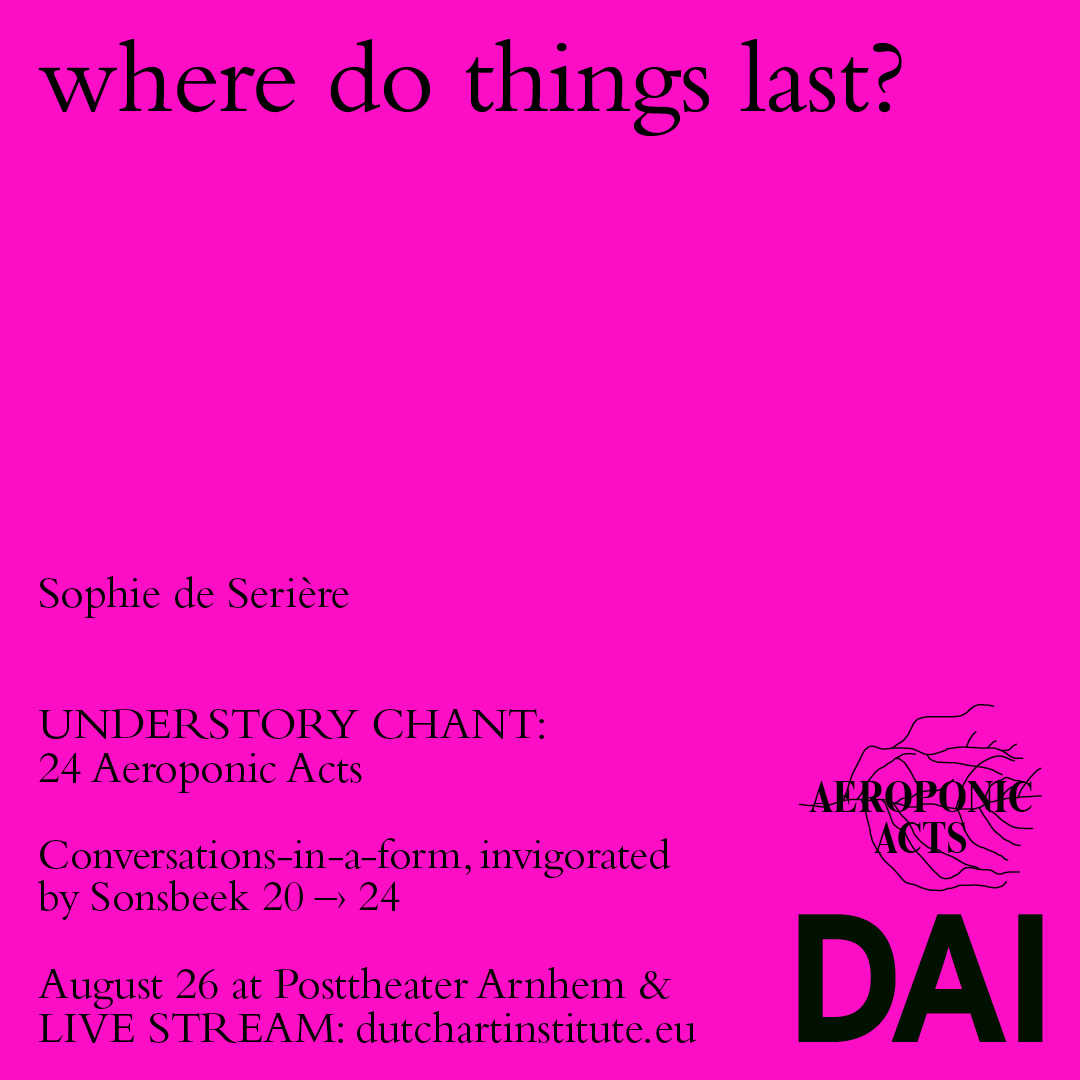Sophie de Serière: where do things last?
‘Aeroponic’ – root systems nourished by air – Acts is the name given to the nomadic Dutch Art Institute’s final & festive iteration of the two year long so-called Kitchen* trajectory. Aeroponic Acts are conversations-in-a-form. Each presenter addresses one question as a practice of engagement.
Here you will find the documentation of Sophie de Serière's presentation as filmed by Baha Görkem Yalım, followed by a written report, authored by Harun Morrison, which includes a summary of the spoken comments by esteemed guest respondents Barby Asante, Lisette Lagnado and Momtaza Mehri.
Interbeing: A proposal to meet
Ilgın's question: where do things last?
Ilgın's introduction:
we can practice it
on the edge of a leaf
left to ourselves
going over deities that lose
their shape
those nights when
our hair becomes the same
and I go through things
Harun's report: We are enjoined to leave the theatre and move to the courtyard outside. We encounter an array of everyday objects, sensitively and informally arranged. A pink door lent against a wall. A ceramic cup on a post. After a period of the audience wandering and looking, Sophie explains she spent a week in Arnhem looking for discarded things. Sophie reflected on this as an extension of her ongoing practice of walking and scouring a given city. She reflected on the status of discarded objects, how once they’re removed from the trash, they’re not seen as such any more, how an act of displacement also shifts status and perception. Each time we find we lose.
Lisette Lagnado: Thanks for taking us outside. It was lovely to think of you performing an opening. The objects were also performing. We had all the elements of an exhibition without the white cube, which made us all the more vigilant. So things found on the street remain in the street. Is it me or is it Arnhem? What is your topic, what is your subject? I’m reminded of a short anecdote from Hélio Oiticica: He happened to be writing by his window, and saw a wooden construction fall apart. It’s common in cities where you have the debris of demolition. The transformation of such occurences in urban space you can call art because your eye can contextualise them as such.
Barby Asante: How do we make meaning from objects? How do we gather ourselves through things? There’s an untapped potential in considering the memory of an object. I'm thinking Toni Morisson here. . . that objects have ‘re-memory’. I’m struck by the privilege of being able to name an object. To name and provide memory assigned to objects. . . Then people who have to let go of objects. . . I was also thinking about object privilege. Who gets to keep objects and be sentimental about objects. . . Being in the West and having an obsession about object-preservation, how does this compare to people who need to adapt, to jettison objects. . . The politics of objects in relation to nostalgia.
Momtaza Mehri: The sun was on your side, that’s a great omen. I’m thinking about the US artist Beverly Buchanan’s series of ‘shack houses’. How the shack can be seen as a homage to resourcefulness. We can apply a similar reading to these objects in Arnhem in terms of the symbolic and memorialising power of objects. What is repurposed and what is found? Doors are liminal, thresholds and entry points. / I collect plane tickets. Things that many consider to be useless. / We should give thought to those in encampments, the strategies of people who are unhoused.
Sophie de Serière's "where do things last?" was presented before live audience at the Posttheater in Arnhem on August 26th.
Find the overview of all 24 AEROPONIC ACTS 2021 here: UNDERSTORY CHANT

